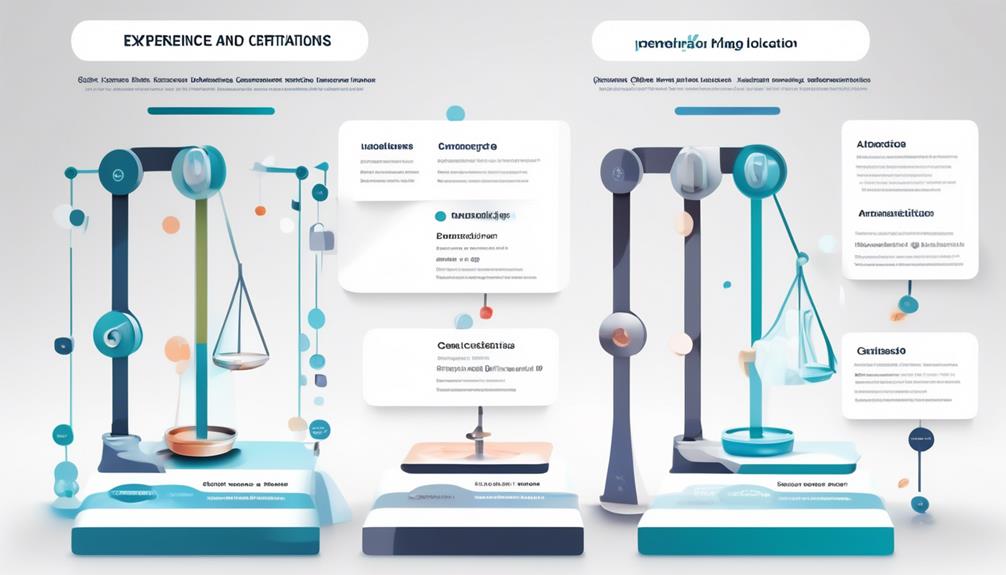Fundamentals of SQA
Understanding Software Reliability & Best Practices

Software reliability is essential for applications to function smoothly and error-free. By following best practices, organizations can enhance the reliability of their software, reducing the likelihood of defects and problems. This article aims to delve into the core principles of software reliability and offer guidance on the best practices to implement for improving software reliability.
Key Takeaways:
- Software reliability is essential for error-free applications.
- Implementing best practices improves software reliability.
- Minimizing failures and defects is crucial for robustness.
- Understanding software reliability fundamentals is important.
- Enhancing software reliability is achievable through best practices.
The Importance of Software Reliability
Software reliability plays a crucial role in the overall performance and dependability of IT systems. This is especially important for federal government Information Technology (IT) systems, which encompass National Security Systems (NSS) and Defense Business Systems (DBS). In order to ensure the success of these systems, it is imperative to implement a comprehensive software reliability program.
A robust software reliability program focuses on establishing common definitions, implementing useful metrics, and ensuring effective defect identification and removal. By incorporating reliability engineering practices and software quality assurance techniques, organizations can enhance the reliability of their software applications and minimize the occurrence of failures or defects.
Reliability engineering involves applying engineering principles to improve the reliability of systems, including software. It encompasses various activities such as reliability modeling, analysis, prediction, and testing. By employing reliability engineering techniques, organizations can identify potential weaknesses in software and take proactive measures to enhance its reliability.
“Software reliability is not only crucial for achieving error-free operation, but also for maintaining the integrity and security of critical IT systems.”
Software quality assurance (SQA) plays a vital role in ensuring software reliability. It involves the systematic monitoring, evaluation, and improvement of software processes to ensure that the software meets specified requirements and quality standards. By implementing robust SQA practices, organizations can identify and resolve defects early in the software development lifecycle, leading to improved software reliability.
Effective software reliability engineering and software quality assurance practices contribute to the delivery of high-quality software that meets user expectations. They help in minimizing system failures, enhancing customer satisfaction, and reducing the costs associated with software defects and failures.
Integrating software reliability practices into the software development process is essential for organizations that aim to provide reliable and resilient software applications. By prioritizing software reliability and adopting best practices, organizations can foster the development of software that operates consistently, performs optimally, and meets the needs of users.
Software reliability is a critical aspect of modern IT systems, and investing in reliability engineering and software quality assurance is imperative for organizations seeking to deliver robust and dependable software applications.
Why Software Reliability Matters
Software reliability is not only crucial for achieving error-free operation, but also for maintaining the integrity and security of critical IT systems. Consider the following reasons why software reliability matters:
- Minimizes system failures and downtime
- Enhances user experience and satisfaction
- Reduces costs associated with software defects and failures
- Ensures the trustworthiness of software-based systems
- Maintains data integrity and protect against security breaches
By prioritizing software reliability, organizations can build resilient and trustworthy software applications that meet user expectations, and ensure the smooth and efficient operation of critical IT systems.
| Software Reliability Program Components | Description |
|---|---|
| Common Definitions | Establishing clear and consistent definitions of software reliability and related terms to facilitate effective communication and understanding. |
| Useful Metrics | Implementing metrics to measure and monitor software reliability, such as MTBF (Mean Time Between Failures) and failure rates, to assess the performance and effectiveness of software applications. |
| Defect Identification and Removal | Implementing processes and methodologies to identify and remove defects throughout the software development lifecycle, thereby improving the overall reliability and quality of the software. |
Software Reliability Definition and Metrics
In the realm of software development, software reliability is of utmost importance. It refers to the probability of failure-free software operation within a specific environment and time frame. While software reliability is not solely dependent on time, it is influenced by various factors, such as defects and failures. To accurately assess and track software reliability, metrics are used to measure key factors, including failures, defects, and reliability data collected during system development and operation.
Understanding software reliability begins with grasping its definition and significance. It encompasses the ability of software to perform its intended functions without experiencing failures or errors. This reliability is not merely limited to the absence of defects at a single moment in time; instead, it measures the sustained performance of the software over a designated period.
Reliability metrics provide valuable insights into the behavior and performance of software. By tracking and analyzing these metrics, software teams can identify areas for improvement and monitor the effectiveness of reliability-enhancing strategies. Some common reliability metrics include:
- Failure Rate: This metric quantifies the rate at which failures occur over a specified time period. It provides an indicator of the software’s stability and reliability.
- Mean Time Between Failures (MTBF): MTBF measures the average duration between software failures. It helps organizations assess the reliability of their software products and predict the intervals at which failures might occur.
- Defect Density: Defect density is a metric that measures the number of defects discovered in a specific unit of software, such as lines of code or function points. It provides insights into the quality of the software and allows for targeted defect-resolution strategies.
- Reliability Growth: Reliability growth metrics track the improvement in software reliability over time. By monitoring the decrease in failure rates and increase in stability, teams can measure the effectiveness of their reliability improvement efforts.
“A reliable software solution ensures seamless functioning and minimizes the risk of disruptions, ultimately leading to customer satisfaction and business success.”
Effective utilization of these metrics enables organizations to identify reliability issues early on, implement appropriate improvements, and build software that meets the highest quality standards. By continuously tracking and enhancing software reliability, businesses can deliver reliable, error-free applications that exceed customer expectations and foster long-term success.
Software Reliability Improvement Techniques
In order to enhance software reliability, various techniques and approaches can be employed. By implementing these methods, organizations can ensure the smooth and error-free operation of software-based systems. Some of the key techniques for improving software reliability include:
- Identifying and Removing Defects: Thoroughly examining the software code and identifying any defects or errors is crucial for enhancing reliability. By using tools such as code analyzers and debugging techniques, developers can locate and eliminate defects that may lead to system failures.
- Capturing and Processing Failure and Defect Data: Keeping track of failure and defect data helps in understanding the weak points of the software and enables targeted improvements. Analyzing and processing such data provides valuable insights into patterns and trends, allowing organizations to address the root causes of failures and enhance overall reliability.
- Developing Operational Profiles: Understanding the usage patterns and operational characteristics of a software system is essential for improving reliability. By developing operational profiles, organizations can identify the critical scenarios and stress points that need to be considered during the software development process. This enables the implementation of targeted reliability measures.
- Implementing Reliability Best Practices: Incorporating reliability engineering principles and best practices throughout the software development lifecycle is crucial for ensuring software reliability. These best practices include rigorous testing, code reviews, and adherence to coding standards. By following these practices, organizations can minimize the likelihood of errors and failures in their software.
- Applying Statistical Techniques: Statistical techniques can be employed to analyze software reliability data and make informed decisions regarding improvements. By applying statistical analysis to failure and defect data, organizations can identify trends, predict future failures, and take proactive measures to prevent them. This helps in ensuring the reliable operation of software-based systems.
Benefits of Software Reliability Improvement
Implementing software reliability improvement techniques offers several benefits for organizations:
- Enhanced Customer Satisfaction: Improved software reliability leads to better customer experiences, as they encounter fewer failures and defects while using the software.
- Reduced Downtime: By minimizing failures and defects, software reliability improvements help to reduce system downtime and improve overall productivity.
- Cost Savings: Enhancing software reliability can lead to savings in terms of maintenance costs, bug fixing, and customer support.
- Improved Reputation: Reliable software gains the trust and confidence of users, enhancing the reputation of the organization.
Implementing these techniques and incorporating reliability engineering practices ensures that software-based systems operate smoothly and reliably.
Software Reliability Improvement Techniques Comparison
| Technique | Description | Advantages |
|---|---|---|
| Identifying and Removing Defects | Involves thorough code examination and defect elimination |
|
| Capturing and Processing Failure and Defect Data | Collecting and analyzing failure and defect data to gain insights |
|
| Developing Operational Profiles | Understanding usage scenarios and stress points of the software |
|
| Implementing Reliability Best Practices | Incorporating reliability engineering principles and standards |
|
| Applying Statistical Techniques | Using statistical analysis to analyze reliability data |
|
Importance of Clear Requirements and Documentation
Clear requirements and proper documentation are vital components of successful software development. They serve as the foundation for the development process and facilitate effective communication among all stakeholders. By investing time and effort into defining explicit software requirements and creating comprehensive documentation, developers can ensure a seamless and efficient development process.
Software requirements outline the functionality, features, and constraints of a software application. They serve as a guide for developers, helping them understand the goals and objectives of the project. Additionally, clear requirements enable accurate estimations, efficient resource allocation, and effective collaboration among team members.
Documentation, including design specifications and coding conventions, is another crucial aspect of software development. It provides valuable insights into the architecture, behavior, and expected outcomes of the software application. With proper documentation, developers gain a deeper understanding of the codebase and can easily navigate through complex sections.
Properly documenting software code not only aids in understanding but also plays a vital role in maintaining and updating the code. Well-structured and thoroughly commented code ensures that future modifications can be made with minimal effort and reduces the risk of introducing bugs. Additionally, clear code documentation is invaluable when onboarding new developers, allowing them to quickly grasp the project and contribute effectively.
“Documentation is the love letter that you write to your future self.”
Clear requirements and documentation also enhance the overall quality of the software. They improve communication between developers, project managers, and stakeholders, reducing the likelihood of misunderstandings or misinterpretations during the development process. Documentation serves as a reference point, ensuring that the software meets the intended requirements and allowing for easier troubleshooting and bug fixing.
In summary, clear requirements and documentation are essential for successful software development. They provide a roadmap for the project, enable effective communication, support code understanding and maintenance, and contribute to the overall quality of the software. By prioritizing these practices, developers can streamline the development process, minimize errors, and deliver robust and reliable software solutions.
Choosing the Right Methodology
When it comes to software development, choosing the right methodology is key to project success. Different methodologies, such as agile and waterfall, have their own unique strengths and weaknesses. To make an informed decision, several factors need to be considered, including requirements flexibility, project size, and time constraints.
Agile methodologies are ideal for projects with changing requirements. This approach emphasizes adaptability and collaboration throughout the development process. By breaking down the project into smaller, manageable iterations, agile methodologies allow for continuous feedback and improvement. Teams using agile methodologies can respond quickly to changing market demands and customer needs.
Waterfall methodologies, on the other hand, are better suited for projects with clear goals and strict deadlines. This traditional approach follows a linear progression, with each phase of development completed sequentially. Waterfall methodologies work well when the requirements are well-defined and unlikely to change significantly throughout the project. It provides a structured framework that ensures thorough planning and documentation.
Choosing the right methodology is not about favoring one over the other, but rather aligning the methodology with the unique needs and constraints of the project.
To aid in the decision-making process, a comparison of the key characteristics of both methodologies is presented below:
| Agile Methodologies | Waterfall Methodologies |
|---|---|
|
|
Choosing the right software development methodology is essential for maximizing productivity, meeting project goals, and delivering high-quality software. By carefully considering the project requirements, stakeholders’ expectations, and the team’s capabilities, organizations can select the most appropriate methodology to ensure project success.
Leveraging Frameworks for Efficient Development
Frameworks play a crucial role in software development by providing pre-built code and functionality that streamline the development process. By leveraging software development frameworks, developers can save time, improve efficiency, and ensure high-quality software.
When choosing a framework, it is important to consider various factors such as programming language compatibility, project requirements, security features, and community support. By selecting the right framework that aligns with the project’s needs and the team’s skills, developers can maximize code reusability and efficiency.
Software development frameworks offer a range of benefits, including:
- Code Reusability: Frameworks provide reusable components and modules that developers can utilize in multiple projects, reducing the need to write code from scratch. This not only saves time but also improves overall code quality and consistency.
- Efficiency: With pre-built functionalities and established best practices, frameworks enable developers to expedite the development process and deliver software solutions more efficiently. This allows organizations to meet deadlines and deliver high-quality products.
- Standardization: Frameworks often provide standardized coding conventions and architectural patterns, making it easier for developers to collaborate and maintain code. This ensures consistency across the software development team and enhances code readability and maintainability.
Developers can choose from a wide range of software development frameworks based on their specific preferences and project requirements. Some popular frameworks include:
- React: A JavaScript library widely used for building user interfaces.
- Angular: A full-featured TypeScript-based framework for building scalable applications.
- Spring Boot: A Java-based framework that simplifies the development of robust and scalable web applications.
- Ruby on Rails: A popular framework for building web applications using the Ruby programming language.
The use of frameworks not only enhances the efficiency of software development but also contributes to improved code quality, maintainability, and scalability. By leveraging the power of frameworks, developers can focus on solving complex business problems and delivering innovative solutions.
By choosing the right software development framework, organizations can ensure that their development teams work efficiently, deliver high-quality products, and stay ahead of the competition.
The Importance of Code Documentation
Properly documenting software code is essential for code maintenance and readability. It plays a vital role in helping developers understand the code, facilitating bug identification and resolution, and providing guidance for new developers joining the project. Code documentation should be clear, concise, and utilize different styles such as comments, inline documentation, and external documentation.
“Good code is its own best documentation.” – Steve McConnell
Clear and comprehensive code documentation enables developers to grasp the vision and purpose behind each code module, aiding them in making informed decisions during software maintenance and modifications. It serves as a roadmap by providing explanations for complex algorithms, logic flow, and business rules.
Additionally, code documentation helps in identifying and resolving bugs more efficiently. Detailed documentation allows developers to trace the origin of a problem, making it easier to fix issues and minimize the time taken for troubleshooting.
“The only valid measurement of code quality: How many WTF/minute it generates while re-reading it.” – Anonymous
Moreover, code documentation acts as a guidebook for new developers entering an existing project. It reduces the onboarding time by providing them with a comprehensive overview of the codebase, its structure, and functionality.
Code Documentation Best Practices:
- Use comments: Clearly explain the purpose of each function, class, and code block using inline comments. This helps other developers understand the code’s intent and functionality.
- Provide API documentation: Document the exposed interfaces, parameters, return values, and usage examples to aid integration with other software components.
- Follow coding conventions: Document the coding style, naming conventions, and formatting guidelines to ensure consistency and readability across the codebase.
- Include project description: Describe the purpose, goals, and scope of the project to provide context for future development and maintenance.
- Document licensing: Specify the license under which the codebase is released, ensuring compliance with legal requirements and enabling others to understand its permitted usage.
By prioritizing proper code documentation, software development teams can enhance code maintainability, facilitate collaboration, and improve overall code quality.

Effective Issue Tracking for Bug Resolution
Issue tracking is a crucial aspect of software development as it allows developers to record and manage problems encountered by users and track their resolution. By implementing an effective issue tracking system, organizations can enhance software quality, ensure customer satisfaction, and promote the timely resolution of bugs. Excellent issue tracking practices enable early bug detection, improving software reliability and overall software quality.
One of the key benefits of issue tracking is its ability to streamline the bug resolution process. By capturing and organizing bug reports, developers can prioritize issues based on their severity and impact. This helps in allocating resources effectively, resolving critical bugs promptly, and ensuring that the most impactful issues receive immediate attention. Furthermore, issue tracking tools provide transparency to all stakeholders by offering visibility into the bug resolution process and its progress.
To enhance issue tracking and bug resolution, organizations can utilize various issue tracking tools and platforms. Some popular options include:
- Zendesk: A comprehensive issue tracking and ticketing system that enables efficient bug resolution and seamless communication among stakeholders.
- ClickUp: A versatile project management platform that offers robust issue tracking capabilities alongside other project management features, allowing for a consolidated bug resolution process.
- GitLab: An integrated DevOps platform that includes issue tracking functionality and fosters collaboration, making it easier for developers to report and resolve bugs efficiently.
By leveraging these issue tracking tools, organizations can facilitate effective bug resolution, leading to improved software quality and enhanced customer satisfaction. A well-implemented issue tracking system helps in maintaining a comprehensive record of bugs, tracking their resolution status, and enabling efficient communication between developers and users.
The Power of Effective Issue Tracking
“An effective issue tracking system is the backbone of bug resolution, ensuring that software quality remains high, and customer satisfaction is prioritized. With well-organized and streamlined issue tracking practices, organizations can uncover and address bugs in a timely manner, ultimately delivering reliable software.”
In conclusion, issue tracking is a critical element of software development that enhances bug resolution, software quality, and customer satisfaction. By leveraging issue tracking tools and following best practices, organizations can improve their bug resolution process, streamline communication, and deliver high-quality software. Invest in effective issue tracking practices to ensure comprehensive bug management and prioritize the resolution of critical issues.
| Benefits of Effective Issue Tracking | Example Tools |
|---|---|
| Promotes early bug detection | Zendesk |
| Enhances software quality | ClickUp |
| Ensures customer satisfaction | GitLab |
The Importance of Version Control
Version control is a critical aspect of software development, enabling efficient code management and ensuring smooth software development processes. It allows developers to track and manage changes to software code, providing a comprehensive history of code alterations throughout the development lifecycle.
One of the key advantages of version control is the ability to keep track of different versions of the code. Developers can easily revert to previous versions if necessary, ensuring the stability and integrity of the codebase. This feature is particularly valuable when multiple team members are collaborating on a project, allowing for seamless integration of code changes.
Moreover, version control systems facilitate bug detection and resolution. By keeping a detailed record of code modifications, developers can accurately identify where bugs were introduced and quickly pinpoint the source of errors. This enables them to rectify issues efficiently and deliver high-quality software.
Collaboration is also greatly enhanced through the use of version control. Different team members can work on separate branches, making changes and improvements without affecting the main codebase. These changes can then be easily combined, ensuring a streamlined and efficient development process.
Popular version control systems, such as Git and SVN, offer comprehensive features and are widely adopted in the software development industry. These systems provide powerful tools for code versioning, branching, merging, and conflict resolution, enabling teams to work together seamlessly.
Benefits of Version Control:
- Track and manage changes to software code
- Revert to previous versions if necessary
- Facilitate bug detection and resolution
- Foster collaboration among team members
- Ensure code integrity and stability
“Version control is the foundation of efficient code management and successful software development. It empowers teams to work collaboratively, track changes effectively, and maintain code integrity throughout the development process.”
Comparison of Version Control Systems:
| Version Control System | Key Features |
|---|---|
| Git |
– Distributed version control system – Branching and merging capabilities – Efficient handling of large projects – High performance and flexibility |
| SVN (Subversion) |
– Centralized version control system – Easy to use and learn – Atomic commits for transactional integrity – Excellent support for binary files |

The Significance of Thorough Unit Testing
Thorough unit testing plays a crucial role in ensuring the quality and reliability of software code. By assessing individual code components, unit testing verifies their functionality, detects bugs early on, and ultimately enhances overall code quality. Through comprehensive unit testing, developers can identify and rectify issues before they escalate, leading to more efficient development processes and reduced costs.
Unit tests should cover all code components, including both expected scenarios and intentional failures. This comprehensive approach allows developers to evaluate the effectiveness and robustness of their code. By intentionally triggering failures, unit testing helps uncover potential vulnerabilities, ensuring that the code can handle unexpected scenarios and prevent potential bugs.
There are various tools available that aid in code examination and improve software reliability. Code coverage tools like Parasoft Jtest and Istanbul provide developers with insights into the extent to which their code is tested. These tools assist in identifying areas of the code that require more thorough testing, allowing developers to further enhance code quality and reduce the risk of bugs.
Incorporating thorough unit testing as an integral part of the development process is vital for achieving code stability and reliability. By focusing on code quality and bug detection through unit testing, developers can ensure that their software delivers a robust and error-free experience to end-users.
| Benefits of Thorough Unit Testing | Tools |
|---|---|
| Early bug detection | Parasoft Jtest |
| Enhanced code quality | Istanbul |
| Reduced development costs |
Conclusion
Software reliability is crucial to ensure the robustness and error-free operation of applications. By implementing best practices such as defining clear requirements, choosing the right methodology, leveraging frameworks, documenting code, and conducting thorough testing, organizations can greatly improve software reliability and deliver high-quality software.
Continuous focus on software reliability and adherence to best practices will lead to improved software performance, enhanced customer satisfaction, and overall success in software development projects. Organizations that prioritize software reliability are better equipped to avoid costly failures, minimize downtime, and maintain a competitive edge in the market.
Investing time and effort in implementing software reliability best practices is a wise decision. Organizations should strive for error-free applications that meet customer expectations and withstand the test of time. By prioritizing software reliability, organizations can build trust, establish credibility, and ensure long-term success in the rapidly evolving digital landscape.
Software reliability refers to the probability of failure-free software operation for a specified period of time in a specified environment. It is crucial because it ensures the robustness and error-free operation of applications, leading to improved software performance and customer satisfaction.
Software reliability can be measured using metrics such as failures, defects, and reliability data collected during system development and operation. These metrics help track and assess the reliability of software in real-world environments.
Some techniques for improving software reliability include identifying and removing defects, capturing and processing failure and defect data, and developing operational profiles. These practices help enhance the reliability of software-based systems.
Clear requirements and proper documentation provide a blueprint for the development process, enable effective communication among stakeholders, and aid in understanding, maintaining, and updating software code. They play a crucial role in software development and maintenance. The choice of software development methodology depends on factors such as requirements flexibility, project size, and time constraints. Agile methodologies are ideal for projects with changing requirements, while waterfall methodologies are better suited for projects with clear goals and strict deadlines.
Leveraging frameworks provides pre-built code and functionality, saving time and improving efficiency in software development. Choosing the right framework based on project needs and team skills helps in streamlining development processes and ensuring software quality.
Proper code documentation helps in understanding, maintaining, and updating software code. It facilitates bug identification and resolution and provides guidance for new developers. Clear and concise documentation improves code readability and overall software quality.
Effective issue tracking allows developers to record and manage user problems, enhancing software quality and ensuring customer satisfaction. It helps in early bug detection and streamlines the bug resolution process, providing transparency to all stakeholders.
Version control allows developers to track and manage changes to software code. It helps in collaborating on features, undoing mistakes, finding and fixing bugs, and combining changes from different branches. Popular version control systems include Git and SVN. Thorough unit testing assesses individual code components, detects bugs in early stages, and enhances code quality. It reduces development costs and ensures reliable software operation. Unit tests should cover all code components and include both expected scenarios and intentional failures.
FAQ
What is software reliability and why is it important?
How can software reliability be measured?
What are some techniques for improving software reliability?
Why are clear requirements and proper documentation important in software development?
How do I choose the right software development methodology?
How can leveraging frameworks improve software development?
Why is code documentation important in software development?
Why is effective issue tracking crucial in software development?
What is the significance of version control in software development?
Why is thorough unit testing important in software development?
At the helm of our content team is Amelia, our esteemed Editor-in-Chief. Her extensive background in technical writing is matched by her deep-seated passion for technology. Amelia has a remarkable ability to distill complex technical concepts into content that is not only clear and engaging but also easily accessible to a wide range of audiences. Her commitment to maintaining high-quality standards and her keen understanding of what our audience seeks are what make her an invaluable leader at EarnQA. Under Amelia’s stewardship, our content does more than just educate; it inspires and sets new benchmarks in the realm of QA education.
Fundamentals of SQA
Healthcare QA Analyst Pay Scale Breakdown
Discover the pay scale for Software Quality Assurance Analyst in the Healthcare industry. Learn about salary ranges, job responsibilities, and career growth opportunities in this field.

In the United States, a Software Quality Assurance Analyst working in the healthcare sector usually makes an average annual salary of $90,122. This amount can greatly differ depending on factors such as location, years of experience, and the employer.
However, that’s just the tip of the iceberg when it comes to understanding the intricacies of compensation for QA Analysts in the healthcare sector. The wide range of salaries and the factors influencing them make for an intriguing exploration into the complexities of pay scale in this industry.
Uncovering the top-paying companies adds another layer of interest to the discussion.
Key Takeaways
- The average salary for Software QA Analysts in the healthcare industry is $90,122 per year, with additional cash compensation and total compensation averaging $6,343 and $90,489, respectively.
- Experience significantly impacts salary range, with QA Analysts with 7+ years of experience earning an average salary of $108,836, while those with 1 year of experience earn around $57,643.
- The top paying industries for QA Analysts are Financial Services, Management & Consulting, Insurance, Information Technology, and Human Resources & Staffing, with average salaries ranging from $85,054 to $164,655 per year.
- Location and choice of employer play a significant role in determining salary range, with states like California, Washington, and New Hampshire offering the highest average salaries, and top paying companies including Apple, Bloomberg L.P., Sysintelli, CGI, and System Soft Technologies.
Salary Range for Software QA Analyst in Healthcare
In our experience, the salary range for Software QA Analysts in the healthcare industry typically varies based on factors such as experience, location, and specific employer. According to our findings, the average salary for a Software QA Analyst in the healthcare industry is $84,146, with additional cash compensation averaging $6,343 and total compensation averaging $90,489.
Interestingly, QA Analysts in the healthcare industry with 7+ years of experience earn an average salary of $108,836, while those with 1 year of experience earn around $57,643. This substantial difference demonstrates the impact of experience on the salary range for Quality Assurance Analysts in the healthcare industry.
Moreover, it’s important to note that the top paying industries for Software Quality Assurance Analysts in the United States include Financial Services, Management & Consulting, Insurance, Information Technology, and Human Resources & Staffing. The top paying companies for Software Quality Assurance Analysts such as Apple, Bloomberg L.P., and Sysintelli, offer average salaries ranging from $85,054 to $164,655 per year.
Additionally, the highest paying states for Quality Assurance Analysts are California, Washington, and New Hampshire, with average salaries ranging from $81,826 to $83,752. These insights highlight the significant impact of location and specific employer on the salary range for Software QA Analysts in the healthcare industry.
Factors Affecting Pay for QA Analysts

How do location, education, and experience impact the salary range for quality assurance analysts?
- Location:
The geographic location plays a significant role in determining the salary range for quality assurance analysts. For instance, states such as California, Washington, and New Hampshire offer the highest average salaries for QA analysts, with California leading at an average of $83,752 annually. It’s essential to consider the cost of living and demand for QA analysts in a specific area when assessing potential salary offers.
- Education:
Higher levels of education, such as a bachelor’s or master’s degree in computer science, engineering, or a related field, can positively impact a QA analyst’s salary. Employers often value advanced education and may offer higher compensation to those with relevant degrees and certifications.
- Experience:
The level of experience also significantly influences the salary range for QA analysts. Senior roles such as engineer lead, senior QA analyst/lead, and senior QA engineer tend to command higher salaries. Additionally, individuals with several years of experience in the field may negotiate higher compensation packages.
Understanding how location, education, and experience impact QA analyst salaries is crucial for individuals seeking positions in one of the highest paying industries.
Top-Paying Companies for QA Analysts
Considering the impact of location, education, and experience on QA analyst salaries, it’s evident that the choice of employer also plays a significant role in determining potential compensation packages for professionals in the healthcare industry. In the United States, the healthcare industry ranks among the top 5 paying industries for QA Analysts, with an impressive median total pay of $93,626 per year. When it comes to the highest paying companies for QA Analysts in the healthcare industry, Apple stands out with an average salary of $164,655 per year, offering a compelling compensation package. Other top-paying companies include Bloomberg L.P., Sysintelli, CGI, System Soft Technologies, and SQA Labs, all of which provide competitive salaries and opportunities for additional pay.
To provide a clear comparison of the top-paying companies, the table below outlines the average annual salaries and the number of open jobs for QA Analysts at these companies in the healthcare industry.
Company Average Salary Open Jobs Apple $164,655 5,000 Bloomberg L.P. – – Sysintelli – – CGI – –
The healthcare industry offers lucrative opportunities for QA Analysts, with companies like Apple and CGI leading the way in providing substantial compensation packages.
Compensation Trends for QA Analysts

As software quality assurance analysts in the healthcare industry, we’ve observed notable shifts in compensation trends over the past few years.
The average salary for QA Analysts in healthcare is approximately $90,122 per year, with senior QA Analysts earning a median pay of $121,908 annually. The healthcare industry ranks among the top 5 paying industries for QA Analysts, offering competitive median total pay.
Moreover, top-paying companies in the healthcare sector, such as Apple, Bloomberg L.P., and Sysintelli, offer salaries ranging from $85,054 to $164,655 per year, indicating a range of compensation opportunities for QA Analysts.
These trends underscore the industry’s recognition of the importance of quality assurance in healthcare software and the willingness to compensate professionals accordingly.
Additionally, the presence of roles like QA Analyst IV, with a median salary of $124,423 per year, reflects the opportunities for career growth and higher compensation within the healthcare industry.
These compensation trends affirm the industry’s commitment to quality assurance and its recognition of the value QA Analysts bring to healthcare software development.
Pay Scale Comparison by Industry
In examining pay scales for software quality assurance analysts, it becomes evident that the healthcare industry offers lucrative compensation, positioning it among the top-paying sectors for QA Analysts. The median salary for a QA Analyst in the healthcare industry is $90,122 per year, and top companies like CGI, Sysintelli, and SQA Labs are known for offering competitive pay.
When comparing industries, the healthcare sector ranks among the top 5 highest paying industries for QA Analysts, with a median total pay of $93,626. This demonstrates the industry’s commitment to rewarding QA Analysts competitively.
Moreover, the healthcare industry provides opportunities for career growth and job satisfaction, making it an attractive option for professionals seeking both financial reward and fulfilling work.
As software quality assurance analysts, especially those in the US, consider their career options, the healthcare industry stands out for its robust pay scale and potential for long-term financial security.
Frequently Asked Questions
How Much Does a Software Quality Assurance Analyst Make in the Us?
We make an average of $84,146 per year, with additional cash compensation of around $6,343.
Top paying industries include Financial Services at $110,788 and Insurance at $101,169.
Apple pays an average of $109,132, and Google pays $111,609.
The highest paying states are California, Washington, and New Hampshire, with average salaries ranging from $81,826 to $83,752.
What Is the Highest Salary for a Quality Assurance Analyst?
The highest salary for a quality assurance analyst in the healthcare industry is an impressive $164,655 per year, offered by Apple. This top-paying position showcases the potential for substantial earning in the field.
It’s essential to pursue opportunities with companies like Apple to maximize our earning potential and advance our careers. Such high salaries reflect the value and demand for skilled quality assurance analysts in the healthcare industry.
What Does a QA Analyst Do in Healthcare?
In the healthcare industry, QA analysts play a crucial role in testing and analyzing software and systems to ensure they meet industry and company standards. They develop and implement testing plans, test cases, and test scripts specific to healthcare software.
QA analysts also document findings, report defects, and track resolutions. Their work significantly contributes to patient safety, data security, and overall quality of healthcare systems.
What Is the Highest Salary for a QA Analyst?
We’ve found that the highest salary for a QA Analyst is $124,423 per year for the role of QA Analyst IV.
This information can be valuable for anyone looking to advance in the field.
It’s crucial to stay informed about salary ranges to make the best career decisions.
Conclusion
In conclusion, the pay scale for software quality assurance analysts in the healthcare industry is diverse and can be influenced by various factors.
Like a patchwork quilt, the range of salaries reflects the unique blend of experience, location, and company size.
As the demand for QA analysts in healthcare continues to grow, it’s important for professionals to consider these factors and explore opportunities with top-paying companies to maximize their earning potential.
Rick, our Software Quality Assurance Writer, is the creative force behind many of our insightful articles and course materials. His unique background in software development, fused with his natural flair for writing, allows him to convey complex QA concepts in a way that is both informative and captivating. Rick is committed to keeping abreast of the latest trends and advancements in software testing, ensuring that our content remains not just relevant, but at the forefront of the field. His significant contributions are instrumental in helping us fulfill our mission to deliver premier QA education.
Fundamentals of SQA
Start Your QA Software Career: Entry Essentials
Interested in quality assurance software? Learn how people get into the field and what it takes to succeed in this competitive industry.

Is it accurate to say that a particular educational background is necessary to enter the software quality assurance field? A lot of individuals are curious about the specific steps to enter this field, and it’s not always as simple as one might assume.
While a degree in computer science or engineering is often recommended, there are other important factors to consider. From practical skills to career opportunities and professional development, there’s a lot to explore when it comes to entering the world of quality assurance software.
Let’s uncover the key steps and considerations for aspiring professionals looking to carve out a career in this dynamic industry.
Key Takeaways
- The educational background in computer science, engineering, or mathematics provides a strong foundation for a career in QA software testing.
- Acquiring practical skills in manual testing and automation tools, as well as gaining hands-on experience through internships or projects, is essential.
- Staying updated with the latest advancements in software development and QA methodologies is important for continuous growth in the field.
- Networking, joining professional organizations, and actively participating in practical software testing scenarios are crucial for career advancement and collaboration opportunities.
Educational Backgrounds
When considering educational backgrounds for a career in quality assurance software, majoring in computer science, engineering, or mathematics provides a strong foundation in QA software testing. A computer science degree equips us with the technical skills necessary for software testing, such as programming, data structures, algorithms, and software design principles. Engineering degrees, particularly in fields like software or computer engineering, offer a deep understanding of systems and software development processes, which are essential for QA roles. Mathematics majors develop analytical and problem-solving skills that are crucial for identifying and troubleshooting software issues.
Networking with classmates and instructors during our degree program can provide valuable employment and collaboration opportunities. It’s important to plan our educational path carefully, enrolling in relevant courses such as operating systems software, statistics, and programming to enhance our technical education. By gaining a strong technical education background, we can expand our job opportunities and command a higher salary in the QA industry.
Pursuing a bachelor’s degree is a solid starting point, but we should also consider post-graduate degrees for management or teaching positions in the future.
Practical Skills

After gaining a strong foundation in computer science, engineering, or mathematics through formal education, it’s essential to acquire practical skills in quality assurance (QA) software testing to effectively apply theoretical knowledge in real-world scenarios.
As software quality assurance (QA) professionals, we must develop technical skills in manual testing and automation tools to ensure the reliability and functionality of software systems. Practical experience, gained through internships or hands-on projects, is crucial for mastering the intricacies of software testing and honing problem-solving abilities in diverse testing scenarios.
Staying updated with the latest advancements in software development and QA methodologies is fundamental to excel in this field. Continuous learning and participation in training programs are indispensable for evolving as a competent QA professional. Actively engaging in practical software testing scenarios not only enhances our technical skills but also fosters a deep understanding of industry best practices.
Furthermore, joining professional organizations and leveraging networking opportunities can significantly expand our career prospects and provide valuable insights into the evolving landscape of QA.
Career Opportunities
Quality assurance software testing offers a wide range of career opportunities in various industries, including software production, video games, digital products, web platforms, and communication networks.
As software testers, we can specialize in front-end testing, back-end testing, security testing, writing test plans, and systems testing. The diverse types of testing, such as black-box testing, white-box testing, gray-box testing, manual testing, and automated testing, create multiple career paths within quality assurance.
To advance in this tech job, it’s essential to work with computer languages, object-oriented languages, frameworks, and project management software. Continuous learning and growth are crucial for career advancement. Staying updated with industry trends, participating in training programs, and networking with other QA professionals are vital.
In the tech industry, the role of a QA Engineer is highly valued as they ensure the quality and reliability of software products. The demand for skilled professionals in QA testing is evident, and the career opportunities are vast for those who are methodical, detail-oriented, and passionate about maintaining high standards in the software industry.
Entry-Level Positions

Entry-level positions in quality assurance software testing require a strong foundation in relevant majors such as computer science, engineering, or math.
To secure a position in this field, individuals should consider the following steps:
- Gain practical experience and expand your professional network through internships and hands-on training. This provides valuable exposure to the industry and allows for the application of theoretical knowledge in real-world scenarios.
- Research accredited institutions offering relevant qualifications and consider networking with classmates and instructors for future employment opportunities. Pursuing advanced degrees or certifications, such as an Associate in Software Testing, can enhance qualifications for QA roles.
- Subscribe to industry-related blogs and magazines, engage in STEM classes and activities, and stay updated with industry trends and developments to explore interests in QA. Keeping abreast of the latest technology and methodologies is essential for success in this field.
Professional Development
Gaining qualifications and experience through internships and networking with industry professionals sets the foundation for continuous professional development in quality assurance software testing.
As QA Engineers and Software Testers, we understand the significance of technical education and the job search process. Networking with classmates and instructors is crucial for future employment and collaboration opportunities.
Internships provide valuable hands-on experience in using testing tools, understanding the Development Life Cycle, and working alongside experienced professionals. Continuous learning and growth are essential in this field, requiring us to stay updated with industry trends and participate in training programs and workshops.
Additionally, joining professional organizations such as the American Society for Quality and the Society of Quality Assurance expands our network and job opportunities.
Developing a strong resume, preparing for interviews, and gaining relevant certifications are vital steps to advance our careers in Quality Assurance. Professional development in this field demands a methodical and analytical approach, ensuring we remain at the forefront of industry standards and best practices.
Frequently Asked Questions
How Do I Get Into Quality Assurance Software?
We get into quality assurance software by pursuing high-quality training in computer science, engineering, or math to gain the necessary skills. Practical experience through internships and hands-on learning enhances our qualifications.
Staying updated with industry trends, participating in training programs, and continuously improving our problem-solving and analytical skills are crucial. Networking with industry professionals and tailoring our application documents to match job postings also expands our job opportunities.
How Do I Start a Career in Quality Assurance?
We start a career in quality assurance by pursuing a relevant major like computer science or engineering. We gain practical experience through internships and familiarize ourselves with various testing types.
Enhancing our skills in programming languages and staying updated with industry trends is crucial. Networking with other QA professionals for continuous learning is also important.
Overcoming the objection that it may take time, we commit to ongoing learning and growth in this methodical and analytical field.
How Hard Is It to Get a Job as a Qa?
Getting a job as a QA can be challenging, but with the right skills and approach, it’s achievable. We emphasize continuous learning, networking, and staying updated with industry trends.
Gaining relevant certifications and professional experience through internships and freelance opportunities enhances your chances.
Utilizing job boards, career platforms, and referrals while participating in training programs maximizes your job search success.
It requires dedication, but the rewards are worth it.
How Do I Become a Quality Assurance Engineer Software?
Becoming a quality assurance engineer in software involves gaining a strong understanding of software development, testing methodologies, and tools. It requires learning programming languages, test automation, and honing analytical skills to identify and resolve complex issues.
Obtaining relevant certifications and gaining hands-on experience through internships or entry-level positions is crucial. Continuous learning and staying updated with industry trends is essential in this dynamic field.
Conclusion
In conclusion, getting into quality assurance software is no easy feat. It requires dedication, continuous learning, and honing of skills. It’s a world where every detail matters, and where the tiniest mistake can have significant consequences.
But for those who are passionate about ensuring quality and continuous improvement, the rewards are immeasurable. It’s a challenging yet fulfilling journey that offers endless opportunities for personal and professional growth.
Rick, our Software Quality Assurance Writer, is the creative force behind many of our insightful articles and course materials. His unique background in software development, fused with his natural flair for writing, allows him to convey complex QA concepts in a way that is both informative and captivating. Rick is committed to keeping abreast of the latest trends and advancements in software testing, ensuring that our content remains not just relevant, but at the forefront of the field. His significant contributions are instrumental in helping us fulfill our mission to deliver premier QA education.
Fundamentals of SQA
Navigating Software Quality Assurance Job Locations
Looking for jobs in software quality assurance? Explore various industries such as technology, healthcare, finance, and more to find opportunities in software quality assurance.

As we explore the world of software quality assurance, it appears that we have come to a pivotal point, surrounded by various paths that lead to different career opportunities.
The demand for professionals in this field has been steadily growing, and the avenues for SQA jobs are as diverse as the industries that rely on robust software.
Curious to know where these opportunities lie and how to embark on a fulfilling career in software quality assurance?
Stick with us as we unravel the thriving locations for SQA jobs, highlight the in-demand job titles, and offer strategies for landing coveted roles in this dynamic field.
Key Takeaways
- Insurance companies like COUNTRY Financial and Honeywell, finance companies like AmeriFlex, aerospace giants like Boeing, and technology solution providers like Origami Risk LLC offer job opportunities in Software Quality Assurance.
- Thriving locations for SQA jobs include Bloomington, IL, Alpharetta, GA, and Madison, AL.
- SQA professionals can transition into roles in product management, DevOps, and quality engineering.
- In-demand SQA job titles include Software Development Engineer in Test (SDET), Sr Software Quality Specialist, Software Quality Assurance Analyst, Software Technical Analyst, and Quality Assurance Engineer.
SQA Job Opportunities by Industry
In our exploration of SQA job opportunities by industry, we find that various sectors offer a diverse range of positions for professionals in the field.
Insurance companies such as COUNTRY Financial and Honeywell are seeking skilled individuals for roles like Software Quality Assurance Analyst and Quality Assurance Engineer.
Finance companies like AmeriFlex are hiring for Quality Assurance Analyst jobs.
Aerospace giants like Boeing are offering positions for Quality Assurance Analysts, Engineers, and Software Development Engineers in Test (SDET).
Technology solution providers like Origami Risk LLC are seeking Sr. Software Quality Specialists and Quality Assurance Engineers.
These positions require proficiency in Agile methodologies, Python, database operations, GitLab pipelines, life insurance processes, performance testing, and cloud-based SaaS solutions.
The sheer breadth of opportunities across these industries reflects the growing demand for QA professionals and the diverse career paths available, including transitions to product management, DevOps, customer experience leadership, and enterprise architecture.
Thriving Locations for SQA Jobs

Thriving in various locations such as Bloomington, IL, Alpharetta, GA, and Madison, AL, SQA jobs offer diverse opportunities with remote work options and hybrid schedules, reflecting the adaptable nature of the field.
These locations are home to companies such as COUNTRY Financial, Honeywell, Boeing, and Origami Risk LLC, which actively seek SQA professionals. These positions often focus on insurance processes and Agile methodologies.
With over 15,000 SQA job opportunities in the United States, there’s a robust demand for SQA professionals across different job titles and companies.
Additionally, SQA professionals can leverage their organizational ability and critical thinking skills to transition into roles in product management, DevOps, and quality engineering.
Continuous learning is crucial for SQA professionals to stay updated with industry trends, performance engineering techniques, and software test automation tools.
This adaptability and the diverse opportunities available in these locations make them thriving hubs for SQA jobs.
Career Paths for SQA Professionals
Exploring various career paths for Software Quality Assurance (SQA) professionals involves considering the diverse opportunities available in the field and the potential for leveraging skills in areas such as product management, DevOps, and quality engineering. As SQA professionals, we can advance our careers by transitioning into roles such as Quality Assurance Analyst, Software QA, or Quality Assurance Manager. The table below outlines the key responsibilities and skills required for each of these career paths:
Career Path Responsibilities Required Skills Quality Assurance Analyst Develop and execute software test plans, identify defects, and ensure compliance with quality standards. Strong analytical skills, attention to detail, knowledge of testing methodologies and tools. Software QA Oversee the entire software development process to ensure product quality, identify areas for improvement, and implement best practices. In-depth understanding of software development lifecycle, coding skills, communication abilities. Quality Assurance Manager Lead a team of QA professionals, establish quality standards, and collaborate with cross-functional teams to enhance overall product quality. Project management, leadership, strategic planning, and decision-making skills.
These career paths offer SQA professionals the opportunity to progress into more challenging and rewarding roles, leveraging their expertise to drive quality and innovation within the software development lifecycle.
In-Demand SQA Job Titles

With a growing demand for skilled professionals in the field of Software Quality Assurance (SQA), numerous job titles have emerged to cater to the diverse needs of the industry. These titles include Software Development Engineer in Test (SDET), Sr Software Quality Specialist, Software Quality Assurance Analyst, Software Technical Analyst, and Quality Assurance Engineer.
Each of these positions plays a critical role in ensuring the quality and reliability of software products. The Software Development Engineer in Test (SDET) is responsible for developing and implementing testing processes within the software development lifecycle, while the Sr Software Quality Specialist oversees and manages the quality assurance processes within a company.
The Software Quality Assurance Analyst focuses on identifying and resolving software defects, ensuring that the final product meets quality standards. Similarly, the Software Technical Analyst and the Quality Assurance Engineer roles involve analyzing, testing, and evaluating software systems to ensure they meet specified requirements and standards.
These in-demand SQA job titles reflect the varied responsibilities and specializations within the software quality assurance field, offering opportunities for professionals with diverse skill sets and expertise.
Strategies for Landing SQA Jobs
As professionals seeking to secure positions in Software Quality Assurance (SQA), we can capitalize on our expertise in Agile methodologies and proficiency in Python, along with a deep understanding of data structures, to qualify for SQA roles at esteemed companies like COUNTRY Financial and Honeywell. To enhance our chances of landing SQA jobs, we should also consider gaining experience in developing GitLab pipelines and acquiring knowledge of life insurance processes, which are sought after by companies like AmeriFlex, Boeing, and Origami Risk LLC. Additionally, developing software solutions, supporting testing and problem-solving, and executing quality assurance testing will prepare us for SQA roles at various companies, including positions like Software Quality Analyst – Manual Tester at Cantaloupe Inc, Optomi, Vaporstream, Inc., and IDR, Inc.
Strategies for Landing SQA Jobs Gain expertise in Agile methodologies Proficiency in Python Deep understanding of data structures Develop GitLab pipeline experience Acquire knowledge of life insurance processes Explore software testing and problem-solving Transition to different roles using transferable skills Explore app development for expanded career opportunities Pursue positions at actively hiring companies
Frequently Asked Questions
What Is the Job of a Software Quality Assurance?
As software quality assurance analysts, we develop and execute test plans and cases to ensure software quality. We collaborate with cross-functional teams to identify and report defects, conducting thorough regression testing.
Strong knowledge of testing methodologies, test case design, and test automation tools is essential. This role offers an average salary of $78,000 per year, with opportunities for career growth and specialization.
Continuous learning is crucial to stay updated and access career advancement opportunities.
Is Software Quality Assurance in Demand?
We find that software quality assurance is indeed in high demand, with over 15,000 available jobs in the United States.
Skills in Agile methodologies, Python, database operations, and GitLab pipelines are sought after.
The average salary for QA analysts is $78,000 per year, with potential to earn up to $110,000.
Continuous learning is essential, focusing on performance engineering, software test automation tools, and reducing software defects.
How Hard Is It to Get a Job as a Qa?
Getting a job as a QA can be challenging, but our dedication and expertise make it achievable. We prioritize continuous learning, communication, and collaboration on automation projects.
Our skills open doors to various career paths, such as product management and quality engineering. Staying updated with quality standards and exploring app development enhances our career prospects.
With perseverance and strategic career development, we can secure rewarding opportunities in the dynamic field of software quality assurance.
Where Do QA Testers Work?
Where do QA testers work?
QA testers work in various positions, such as Software Development Engineer in Test (SDET) at companies like COUNTRY Financial and Honeywell. They can also work remotely as Software Quality Assurance Analysts at companies like AmeriFlex and Origami Risk LLC.
These roles require skills in Agile methodologies, Python, data structures, and GitLab pipelines, among others.
QA testers are responsible for designing solutions, executing testing procedures, and collaborating with development teams to resolve software issues.
Conclusion
In the ever-evolving landscape of software quality assurance, opportunities abound like stars in the night sky. With the right skills and determination, SQA professionals can navigate the constellations of job titles and industries to find their perfect fit.
By honing their expertise and embracing new challenges, they can illuminate their career path and reach for the brightest opportunities.
The possibilities are endless, and the journey is full of promise and potential.
Rick, our Software Quality Assurance Writer, is the creative force behind many of our insightful articles and course materials. His unique background in software development, fused with his natural flair for writing, allows him to convey complex QA concepts in a way that is both informative and captivating. Rick is committed to keeping abreast of the latest trends and advancements in software testing, ensuring that our content remains not just relevant, but at the forefront of the field. His significant contributions are instrumental in helping us fulfill our mission to deliver premier QA education.
-

 Resources and Training3 months ago
Resources and Training3 months agoMaster Selenium Webdriver Training Today!
-

 SQA Techniques and Tools3 months ago
SQA Techniques and Tools3 months agoUnveiling the Role of Software Quality Assurance: What Do They Really Do?
-

 SQA Techniques and Tools3 months ago
SQA Techniques and Tools3 months agoUnlock Your Potential: How to Become a Quality Assurance Software Tester and Earn a Competitive Salary
-

 Fundamentals of SQA3 months ago
Fundamentals of SQA3 months agoHow Do You Structure a Quality Assurance Team?
-

 SQA Best Practices3 months ago
SQA Best Practices3 months agoElevate Your Tech with Software Quality Assurance
-

 Process Enhancement3 months ago
Process Enhancement3 months ago9 Continuous Improvement Tactics for QA Success
-

 Fundamentals of SQA3 months ago
Fundamentals of SQA3 months agoUnderstanding Definition and Scope of Software Quality Assurance (SQA)
-

 SQA Best Practices3 months ago
SQA Best Practices3 months agoMastering Bug Testing: Expert Tips and Techniques for Software Quality Assurance













